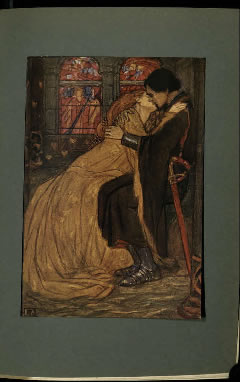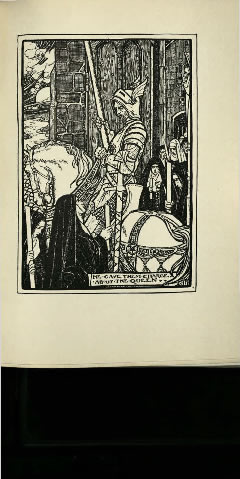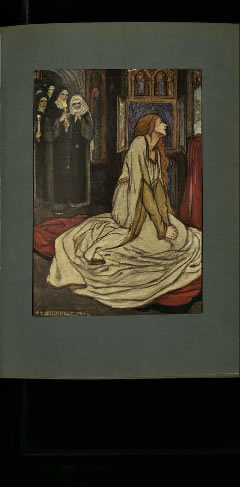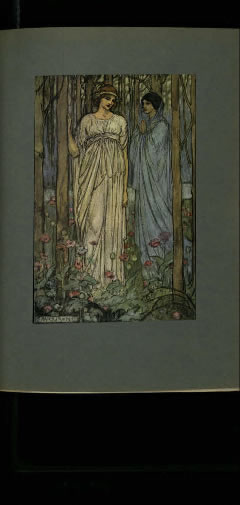Guinevere and Other Poems
You may click on the thumbnail images to view them full screen
Alfred Lord Tennyson, Guinevere and Other Poems, Illustrated by Florence Harrison (London: Blackies & Sons, 1912)
Florence Harrison was an illustrator known for providing images to accompany poetry, such as 'The Goblin Market' and works by William Morris. She was influenced in both style and content by the Pre-Raphaelites, as well as the art-deco movement. Originally published in 1912, a revised edition of Tennyson's Guinevere and Other Poems, excluding several of the images, was reprinted in 1923. Unlike her predecessors, Harrison often portrays Guinevere in a positive light, emphasizing Guinevere's role as the title character of the book, thereby changing the meaning of Tennyson's poetry to be more favourable to the queen.
 Cover Page: An engraving with the title, Tennyson's Guinevere and Other Poems.
Cover Page: An engraving with the title, Tennyson's Guinevere and Other Poems.

Queen Guinevere Had Fled the Court: The cover page of the book, with an illustration of Guinevere fleeing Camelot.

It was their last hour: Guinevere and Lancelot embrace while Mordred plots to expose their affair. 'Low on the border of her couch they sat/Stammering and staring. It was their last hour,/A madness of farewells.'

Lancelot and the Fairy Circle: Lancelot comes across fairies as he travels. From the lines 'And still at evenings on before his horse/The flickering fairy-cycle wheeled and broke/Flying, and linked again, and wheeled and broke/Flying, for all the land was full of life.'

She made her face a darkness for the king: Queen Guinevere grovels before King Arthur when he finds her at Almesbury. 'There with her milkwhite arms and shadowy hair/She made her face a darkness from the King:/And in the darkness heard his armed feet/Pause by her'.

He Gave Them Charge About The Queen: After King Arthur gives his final farewell to Guinevere, he commands the nuns 'to guard and foster her for evermore'. He leaves Almesbury to meet Mordred in a final battle that will end in his death.

Grieving Guinevere: Guinevere sits looking out a window after Arthur has left for battle. Guinevere expresses regret for her actions, saying, 'we needs must love the highest when we see it,/Not Lancelot, nor another.'

Three Angels Bear the Grail: Sir Galahad kneels on a boat praying while above him three angels hold the Holy Grail.

A Dream of Fair Women: This image is from the poem called 'A Dream of Fair Women' by Tennyson. The narrator sees two women in the woods, one is 'a daughter of the gods, divinely tall,/And most divinely fair', while the other had her youth '"blasted with a curse"' by the beautiful woman.

Arthur's Death: Arthur is fatally wounded in his battle against Mordred. Three queens arrive in a barge and the fairest 'laid his head upon her lap.'